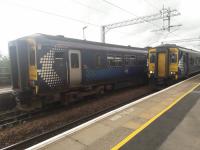Glasgow, Barrhead and Neilston Direct Railway
Introduction
This line is open. Today it is part of the line known as the Glasgow, Barrhead and Kilmarnock or GBK. It purchased the Glasgow Southern Terminal Railway to extend the final mile to its Glasgow terminus South Side [GB and NDR]. The line was worked by the adjoining Glasgow, Paisley and Greenock Railway. It became part of the Caledonian Railway and then it became jointly owned with the Glasgow and South Western Railway as the joint Glasgow to Kilmarnock route. With this, it became part of the main line to London St Pancras, the route via Barrhead being shorter (although more arduous) than that via Paisley. Joint ownership ended with the joint companies being grouped into the London, Midland and Scottish Railway. Today, the line between Glasgow Central and Barrhead is supported and promoted by the South West Glasgow Community Rail Partnership .
Dates
Route described
This line runs south west from Glasgow to Barrhead, steadily climbing and latterly running in the valley of the Levern Water during the steeper climb to Barrhead. Along its route there are three large viaducts Pollokshaws Viaduct, just outside Glasgow, Kennishead Viaduct and Levern Water Viaduct on the eastern edge of Barrhead.
The line served several works (such as the Thornliebank Dye Print and Bleach Works, Nitshill Chemical Works, Shanks Victorian Pottery Works, Fereneze Works, Crofthead Mill) and mines.
The Glasgow South Side [GB and NDR] terminus was built by the Glasgow Southern Terminal Railway, a short line replacing the original promoted terminus and acquired by the larger company shortly after the railway opened.
Trains ran to that terminal, and later the Glasgow Central and St Enoch stations. Today they run to Glasgow Central.
Locations along the line
These locations are along the line.
This terminus was located at the junction of Pollokshaws Road and Cathcart Street (now Cathcart Road). Initially it was the Glasgow terminus of the Glasgow, Barrhead and Neilston direct Railway. An eastern portion was added to the station, opened with the Clydesdale Junction Railway and Hamilton branch. The terminus was on the south side of the River Clyde, a little distant from old ...
More detailsSee also
City of Glasgow Union Railway
Glasgow Southern Terminal Railway

G H Robin collection by courtesy of the Mitchell Library, Glasgow 20/07/1961

G H Robin collection by courtesy of the Mitchell Library, Glasgow 20/07/1961

G H Robin collection by courtesy of the Mitchell Library, Glasgow 20/07/1961

G H Robin collection by courtesy of the Mitchell Library, Glasgow 20/07/1961
This was a long six road carriage shed south of South Side [GB and NDR], built after 1892 on the east side of the approach to that former station and with the City of Glasgow Union Railway line on its east side on approach to Glasgow St Enoch from Langside Junction to the south. The sidings through the carriage shed were looped.
...
See also
City of Glasgow Union Railway
This was a junction on the approach to Glasgow St Enoch from the south until 1973.
...
See also
Glasgow Southern Terminal Railway

...
Bill Roberton 02/08/2021

Robin McGregor 26/09/1964

Bill Roberton 02/08/2021

Robin McGregor 16/04/1965
This junction remains open. This is the junction between the main line south from Glasgow Central to Barrhead and the freight only curve to Larkfield Junction. It was once a goods junction and later the junction between the routes to Glasgow St Enoch and Glasgow Central.
...
See also
General Terminus and Glasgow Harbour Railway

...
Bill Roberton 26/04/2021

Robin McGregor 19/04/1965

David Panton 25/08/2018

Fraser Cochrane 29/12/2008
This was a two platform station on the Glasgow to Barrhead line with waiting rooms on the platforms and an office on the road overbridge at the north east end. The city bound platform was larger than the southbound platform and had ornamental gardens.
...

Network Rail 11/06/2023

Network Rail /03/2023

Gordon Steel 01/09/2022
This is a two platform station. It is a minimal station with two platforms.
...

David Panton 20/06/2018
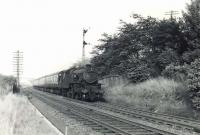
G H Robin collection by courtesy of the Mitchell Library, Glasgow 20/09/1963

John Yellowlees 08/11/2021

G H Robin collection by courtesy of the Mitchell Library, Glasgow 14/07/1964
This goods and minerals depot was located to the north of Pollokshaws West station and the Pollokshaws Viaduct. The yard was on both sides of the line. The goods shed and loading bank was on the east side, approached from the south. Sidings on the west side were approached from the north.
...

Robin McGregor 02/07/1966

See
G H Robin collection by courtesy of the Mitchell Library, Glasgow 09/08/1956

Robin McGregor 02/07/1966
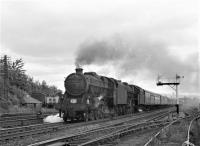
Robin McGregor 16/07/1966
This is a double track five arch viaduct, over the White Cart Water, north of Pollokshaws West station.
...

G H Robin collection by courtesy of the Mitchell Library, Glasgow 15/09/1964

Graham Morgan 28/05/2007

G H Robin collection by courtesy of the Mitchell Library, Glasgow 04/08/1964

G H Robin collection by courtesy of the Mitchell Library, Glasgow 31/08/1964
This is a two platform station with original station buildings on both platforms. It is now the oldest station in the Glasgow area.
...

David Panton 04/05/2019

Bill Roberton 16/04/2023

Bill Roberton 16/04/2023

Bill Roberton 02/01/2020
...
More detailsThis coal depot was a single siding which made a trailing connection to the southbound line immediately north east of Busby Junction. The Auldhouse Bleachfields was to the east, (ii later became the Eastwood Engine Works).
...
This is the junction between the line from Glasgow Central to Kilmarnock and the branch to East Kilbride.
...
See also
Busby Railway

G H Robin collection by courtesy of the Mitchell Library, Glasgow 08/09/1956
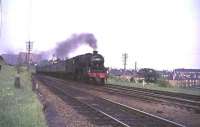
G W Robin /08/1965

G H Robin collection by courtesy of the Mitchell Library, Glasgow 08/09/1956

G H Robin collection by courtesy of the Mitchell Library, Glasgow 06/10/1953
This is a two platform station. The station has few facilities. A footbridge crosses between the platforms.
...
See also
Spiersbridge Branch (Glasgow, Barrhead and Neilston Direct Railway)

...
David Panton 14/10/2017
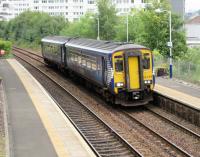
David Panton 08/09/2018
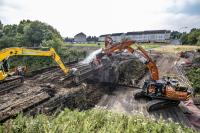
Network Rail /08/2022
This double track viaduct is west of Kennishead station and directly west of the new bridge by which the M77 crosses over the railway.
...

John Robin //1965

John Robin 31/03/1965

John Robin 31/03/1965

Colin Harkins 25/02/2007
This is a relatively new minimal two platform station, of 1990, opened to serve housing developments.
...

David Panton 08/09/2018

G H Robin collection by courtesy of the Mitchell Library, Glasgow 04/08/1955

David Panton 12/01/2008
This is a two platform station with a lattice footbridge. The platforms are slightly staggered.
...

Robin McGregor 16/07/1966

Robin McGregor 27/08/1966

David Panton 08/09/2018
This is a large masonry two track structure. There are two large arches over the Levern Water to the west, a large masonry section and then a smaller arch over Salterland Road to the east. The viaduct is 50 ft high. Also known as Salterland Viaduct.
...

G H Robin collection by courtesy of the Mitchell Library, Glasgow 21/03/1957
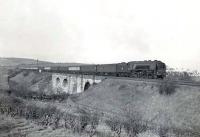
G H Robin collection by courtesy of the Mitchell Library, Glasgow 21/03/1957
This junction was east of Barrhead. It opened in 1902 when the 1848 Glasgow, Barrhead and Neilston Direct Railway was met by the Barrhead Branch (Glasgow and South Western Railway) and, in particular, its curve from Blackbyres Junction [G and SW].
...
See also
Barrhead Branch (Glasgow and South Western Railway)

Ewan Crawford //1999

G H Robin collection by courtesy of the Mitchell Library, Glasgow 10/04/1953
This junction was north east of Barrhead station. It was the junction for Barrhead Central. This was a double track junction. On the north side of the junction was the Shanks Victorian Pottery Works, served by a siding making a trailing connection to the Barrhead-Glasgow line.
...
See also
Barrhead Branch (Glasgow and South Western Railway)

G H Robin collection by courtesy of the Mitchell Library, Glasgow 06/10/1956

G H Robin collection by courtesy of the Mitchell Library, Glasgow 10/04/1953

G H Robin collection by courtesy of the Mitchell Library, Glasgow 10/04/1953

G H Robin collection by courtesy of the Mitchell Library, Glasgow 10/04/1953
This is a three platform station to the south west of Glasgow. One platform, on the north side, is a bay platform for Glasgow. It enjoys a commuter service to Glasgow Central and is also served by longer distance trains between Glasgow and Carlisle. A signal box (dating from 1894) still stands to the east of the station.
...

John Yellowlees 11/12/2023

Network Rail 06/12/2023

John Furnevel 17/08/2006
This intermediate box was on the south side of the line between Barrhead and Neilston [1st].
...

Robin McGregor 17/10/1965

G H Robin collection by courtesy of the Mitchell Library, Glasgow 06/05/1954

G H Robin collection by courtesy of the Mitchell Library, Glasgow 06/05/1954
This was a shed located by the first Neilston station, Crofthead, a terminus to the north of Neilston.
...
This was a terminus. When initially opened the line from Barrhead was single track. The line terminated with a loop and two sets of goods sidings. There was a shed, Neilston Shed.
...
See also
Glasgow and Kilmarnock Joint Railway

Robin McGregor 17/10/1965

Ewan Crawford 14/09/2017














